The Japanese have a proverb: "He who climbs Mount Fuji once is a wise man, he who climbs it twice is a fool." For the Japanese, Mt Fuji is not just their highest mountain (and 35th highest in the world), but their most sacred. Revered for centuries for its beauty and symmetry, it has inspired countless works of Japanese art and literature through the course of Japanese history. But if you ask ten random Japanese people on the street, maybe seven will tell you they have never climbed Mt Fuji. They might also tell you they have no intention of climbing one of their treasured national symbols, and probably think you're crazy to try. As one Japanese friend remarked: "We Japanese admire Mt Fuji – from afar."
Our plan was simple: we would climb the Kawaguchi-ko trail from the Fifth Station (a bit over half way up the mountain) overnight so we would summit at sunrise. After that we would descend, enjoying the daylight views of Japan from almost four kilometres up before getting a bus back to Tokyo. Sounds easy, doesn't it?
We arrived at the Fifth Station (Go-gome) just as the sun was slipping over the horizon, giving us barely enough light to see that we were already above the clouds. It was a lot cooler here than it was down in the foothills, and we were only half way up the mountain. We had arrived a bit too early, so our first stop was the souvenir store ('cause when in Japan…) which gave us some shelter while browsing.
We set off up the Kawaguchi-ko trail in pitch black (9:30 p.m.), reaching the Sixth Station (2,390 metres) at 10:15 p m. It was a good warmup – a taste of what was to come. The police at the Sixth Station handed us a pamphlet with elevation and timing details. The portaloos around the corner gave us its filthy stench. After snapping a quick photo, we headed off.
The next part was mostly manmade trails that zig-zagged their way up the mountain. Our steady diet of fast food and desk jobs started to show, but it got easier as we settled into our strides. Reaching the Seventh Station at about 11:30 p.m., we took our first long rest. The air was starting to thin now, not immediately noticeable, but after a while things seem a little bit harder than before. A nagging worry settled in – would we summit by dawn? Would we succeed? Two hours of climbing behind us and we still had another 1,000 meters to go – a daunting thought.
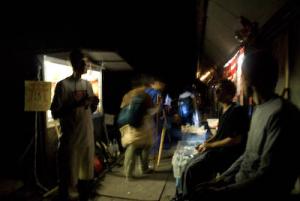
 Shops selling basic food and drinks can be found at
each station along the climb
Shops selling basic food and drinks can be found at
each station along the climb
The climb up to the Eighth Station revealed a few interesting parts of the trail. We left behind the gravel roads for sharply rising rock faces. It was no cliff, but it provided some entertainment (and consternation), especially when carrying a heavy pack. Here the walking sticks proved more of a hassle; you needed both hands to grab the hand holds at times, the stick got in the way. Exhaustion set in as we reached the Eighth Station (3,020 meters), at roughly 1:30 a.m. Most of us had been up since eight in the morning the previous day, with little sleep in between. The combination of climbing and thinning atmosphere became an obstacle. Retreat was not an option – if children and grandparents could do this, so could a group of desk jockeys.
By 2:30 a.m. we had reached the Fujisan Hotel (3,360 metres). This was the original Eighth Station – the previous was a new stop, presumably to break up the climb for weary climbers, as well as being the location for a first-aid station. We made good time from the last stop. After a good rest and some food, we hit the trail for the last 400 odd metres to the summit.
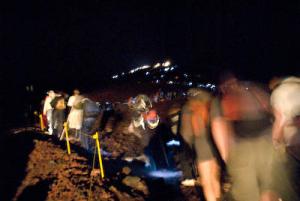
 Climbers trekking towards the summit
Climbers trekking towards the summit
Above the Clouds
The last few hundred metres of elevation were excruciating. By now, my legs were sore, my back, knees and ankles were aching from the load of my backpack and the constant climbing. The thinner air made my heart work harder to get power to my legs – it was about to beat its way out of my chest. The slight headache I had amplified, and I could feel the bruises on my back from the straps of my backpack. We stopped frequently. The cold made us more lethargic. Things were looking a bit grim.
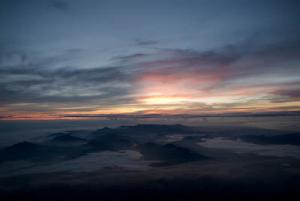
 Sunrise on Mt. Fuji
Sunrise on Mt. Fuji
Fuji lived up to its reputation of being a crowded place during climbing season – there were hundreds of people wielding torches, winding their way up the mountain, like a trail of fireflies. The good thing was that it gave us an idea of how far away the summit was; the bad thing was that the summit seemed further away. By 4:15 a.m., we made it up to within 100 metres of the summit. It was obvious we were not going to summit in time. Other climbers had come to the same conclusion.
We found a spot to sit down, got the load off our backs and enjoyed the sunrise. Luckily, the Kawaguchi-ko trail faced east, giving us a perfect view of the sunrise – which was absolutely magnificent. From our vantage point we could see the peaks of surrounding mountains rising through the cloud cover like small islands; through the clouds we could make out Kawaguchi-ko, one of the five lakes surrounding Fuji, and the towns around the area. There were more clouds above that from which the sun burst through, its light scattered and reflected, then, gathering in strength, rising dramatically to herald the start of a new day. Around us, climbers watched quietly, in awe, and perhaps with reverence: this was what we came to see.
With renewed enthusiasm (and a good hour's rest), we made the last push up. In daylight we could see what it was we were climbing – a huge mound of rock made by billions of tons of lava over millions of years. And the view! The view! Daylight showed how high we had come. It was high. And it showed us exactly how far away the summit was, not too far. At 5:45 a.m., after eight and half hours, we finally made it.
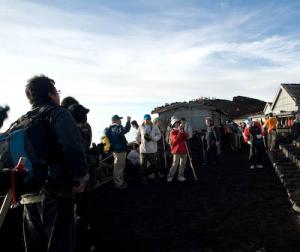
 Climbers on the summit
Climbers on the summit
The World's Highest Truck Stop
We had preconceptions of what the summit looked like from descriptions and travel guides. All mentioned the vending machines, the hawkers, the post office, and the hour long walk around the crater. I pictured the typical Japanese urban flare on top of its most revered mountain, and the image jarred violently in my imagination. Once hitting the summit, though, I was pleasantly surprised at what I saw: stone and wood buildings, benches and a bustling crowd of people. It looked more like a busy Sunday morning in a Nepalese village than a marketer's wet dream, so much so that even the brightly coloured vending machines did not seem out of place. Quite welcomed, actually: the hike up had exhausted my water supply.
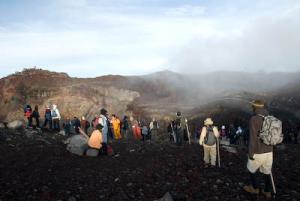
 Crowds line the edge of the crater
Crowds line the edge of the crater
We wandered past the shops, past the most disgusting smelling toilet this side of a sewer, and ambled up to the crater. It was small, at a guess, only 60 metres or so in diameter. All this mountain came from such a small hole? Surprisingly, I also noticed a distinct smell of sulphur in the air near the crater. I was taken aback – Fuji is dormant, right? The last eruption was in 1707, some 300 years ago; during that eruption Fuji, belched a cloud of ash that covered Tokyo some 110 kilometres away.I've since read that some volcanologist suspects the next eruption might not be so far away.
Wandering away from the crater, we found some empty benches to sit on and enjoy the view. I fired up my mobile, and bam! full reception. The mobile signals came from the towers covering the towns below, and with no obstacles between the summit and the towns some 3700 metres below, we managed to get good reception from the summit. I woke a few friends in Australia and abroad with a well timed text message, and I made a couple of phone calls. Bet you can't do that on Everest.
We rested at one of a string of restaurants catering for the weary crowds. They served food, drinks, and provided a bench to sit on and a warm respite from the near-zero Celsius temperatures. Some even offered futons, but the access to a warm flat surface was heaven enough.
The ground around the summit consists of fist-sized volcanic rocks, some of which were quite sharp – making sitting an uncomfortable (and possibly dangerous) experience. I promptly ordered a meal and a drink, paying the premium expected for such a remote location. Food never tasted so good.
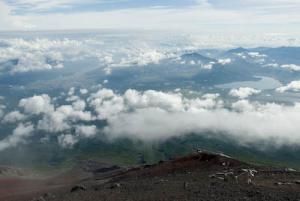
 Looking out over the natural wonders of Mt. Fuji
Looking out over the natural wonders of Mt. Fuji
Coming Down
I had no idea how high we were until we started climbing down. Climbing at night reduced my spatial awareness to the bit of ground a few metres in front of me. The other thing that you notice on the way down is how much difference a hundred meters of elevation makes when you're up that high. It was near-zero up the top, but by the time we had reached the Gansomuro hut (about 3,200 metres, half way between the two Eighth Stations), it was back to T-shirts again.
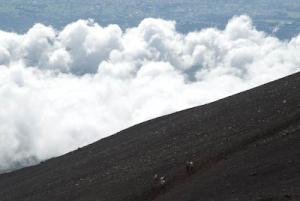
 Climbers making their way down
Climbers making their way down
From the Gansomuro hut we cut across to the descending route, which was basically a service road that zigzaged its way up to the summit. It was steep, made of loose gravel, and an absolute pain to walk on. After two hours of this, even the view failed to distract from the tedium. The best technique was to pick up the pace a little, let your feet slip and use the slippery gravel as part of your suspension. The falls were more spectacular, they lessened the strain on your legs and back. It meant you could get through it a whole lot faster. The hours went by, and eventually we made our way back past Roku-gome (2,390 metres) and on our way to Go-gome.
Back where we started
We arrived at Go-gome at midday, about four hours after leaving the summit. We took a total of 14.5 hours to get to the summit and back, including a two-hour stop on the summit itself. By this time it had been over 24 hours since anyone last had a decent snooze, and it was beginning to show – we would have made good zombies in a Z-Grade slash horror flick – especially since no one had thought to bring sunscreen or even a hat. The four hours in the sun really took its toll.
The trip from Fuji was uneventful, and pleasantly so; the climb was brilliant, but it will be some time before I want to try it again! It's not often that you find out first hand the meaning of a proverb. Fuji-san holds a special place in the heart of many Japanese. Standing on its peak, I got a glimpse into the reverence that influenced centuries of Japanese art and literature. It's true: one may be a fool to climb it twice, but to not climb it at all may be the most foolish thing of all.
John Kung is an English teacher and photographer in Hiroshima, Japan. You can find more of his writing and photography at www.fibrowalls.com.